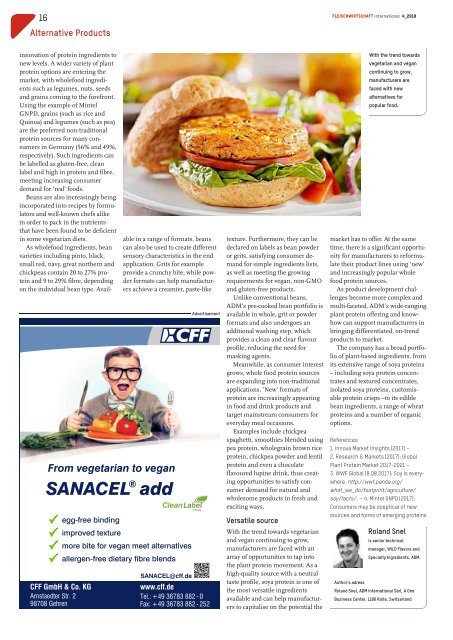FLEISCHWIRTSCHAFT international_04_2018
- No tags were found...
Create successful ePaper yourself
Turn your PDF publications into a flip-book with our unique Google optimized e-Paper software.
16<br />
Fleischwirtschaft <strong>international</strong> 4_<strong>2018</strong><br />
Alternative Products<br />
innovation of protein ingredients to<br />
new levels. A wider variety of plant<br />
protein options are entering the<br />
market, with wholefood ingredients<br />
such as legumes, nuts, seeds<br />
and grains coming to the forefront.<br />
Using the example of Mintel<br />
GNPD, grains (such as rice and<br />
Quinoa) and legumes (such as pea)<br />
are the preferred non-traditional<br />
protein sources for many consumers<br />
in Germany (56% and 49%,<br />
respectively). Such ingredients can<br />
be labelled as gluten-free, clean<br />
label and high in protein and fibre,<br />
meeting increasing consumer<br />
demand for ‘real’ foods.<br />
Beans are also increasingly being<br />
incorporated into recipes by formulators<br />
and well-known chefs alike<br />
in order to pack in the nutrients<br />
that have been found to be deficient<br />
in some vegetarian diets.<br />
As wholefood ingredients, bean<br />
varieties including pinto, black,<br />
small red, navy, great northern and<br />
chickpeas contain 20 to 27% protein<br />
and 9 to 29% fibre, depending<br />
on the individual bean type. Available<br />
in a range of formats, beans<br />
can also be used to create different<br />
sensory characteristics in the end<br />
application. Grits for example<br />
provide a crunchy bite, while powder<br />
formats can help manufacturers<br />
achieve a creamier, paste-like<br />
Advertisement<br />
texture. Furthermore, they can be<br />
declared on labels as bean powder<br />
or grits, satisfying consumer demand<br />
for simple ingredients lists,<br />
as well as meeting the growing<br />
requirements for vegan, non-GMO<br />
and gluten-free products.<br />
Unlike conventional beans,<br />
ADM’s pre-cooked bean portfolio is<br />
available in whole, grit or powder<br />
formats and also undergoes an<br />
additional washing step, which<br />
provides a clean and clear flavour<br />
profile, reducing the need for<br />
masking agents.<br />
Meanwhile, as consumer interest<br />
grows, whole food protein sources<br />
are expanding into non-traditional<br />
applications. ’New’ formats of<br />
protein are increasingly appearing<br />
in food and drink products and<br />
target mainstream consumers for<br />
everyday meal occasions.<br />
Examples include chickpea<br />
spaghetti, smoothies blended using<br />
pea protein, wholegrain brown rice<br />
protein, chickpea powder and lentil<br />
protein and even a chocolate<br />
flavoured lupine drink, thus creating<br />
opportunities to satisfy consumer<br />
demand for natural and<br />
wholesome products in fresh and<br />
exciting ways.<br />
Versatile source<br />
With the trend towards<br />
vegetarian and vegan<br />
continuing to grow,<br />
manufacturers are<br />
faced with new<br />
alternatives for<br />
popular food.<br />
market has to offer. At the same<br />
time, there is a significant opportunity<br />
for manufacturers to reformulate<br />
their product lines using ‘new’<br />
and increasingly popular whole<br />
food protein sources.<br />
As product development challenges<br />
become more complex and<br />
multi-faceted, ADM’s wide-ranging<br />
plant protein offering and knowhow<br />
can support manufacturers in<br />
bringing differentiated, on-trend<br />
products to market.<br />
The company has a broad portfolio<br />
of plant-based ingredients, from<br />
its extensive range of soya proteins<br />
– including soya protein concentrates<br />
and textured concentrates,<br />
isolated soya proteins, customisable<br />
protein crisps –to its edible<br />
bean ingredients, a range of wheat<br />
proteins and a number of organic<br />
options.<br />
References<br />
1. Innova Market Insights (2017) –<br />
2. Research & Markets (2017): Global<br />
Plant Protein Market 2017-2021 –<br />
3. WWF Global (8.08.2017): Soy is everywhere.<br />
http://wwf.panda.org/<br />
what_we_do/footprint/agriculture/<br />
soy/facts/. – 4. Mintel GNPD (2017):<br />
Consumers may be sceptical of new<br />
sources and forms of emerging proteins<br />
With the trend towards vegetarian<br />
and vegan continuing to grow,<br />
manufacturers are faced with an<br />
array of opportunities to tap into<br />
the plant protein movement. As a<br />
high-quality source with a neutral<br />
taste profile, soya protein is one of<br />
the most versatile ingredients<br />
available and can help manufacturers<br />
to capitalise on the potential the<br />
Author’s adress<br />
Roland Snel<br />
is senior technical<br />
manager, WILD Flavors and<br />
Specialty Ingredients, ADM.<br />
Roland Snel, ADM International Sàrl, A One<br />
Business Center, 1180 Rolle, Switzerland

















